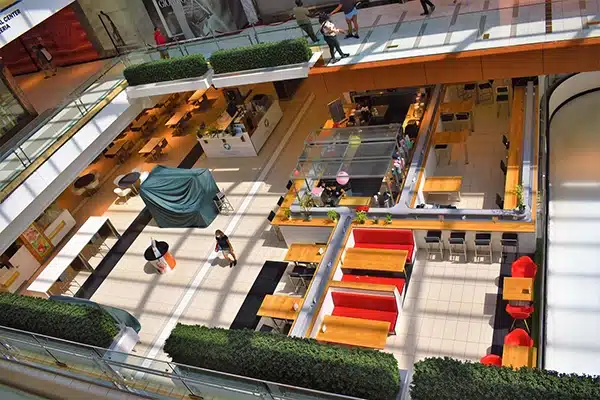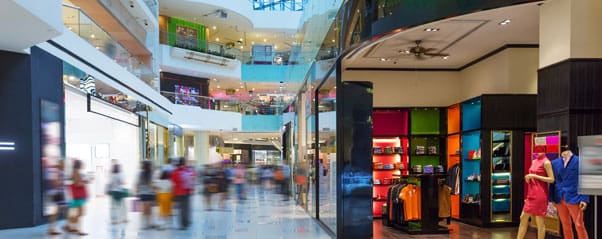Imagine strolling through a bustling shopping mall, browsing the latest fashion trends or searching for that perfect gift. The last thing you want to encounter is a pest problem. That’s where pest control in shopping malls comes in. From small rodents scurrying through the stores to pesky insects making their way into the food court, this article explores the importance of effective pest control measures in keeping these popular retail spaces clean, safe, and pest-free. Find out how expert pest control professionals tackle these challenges to ensure a pleasant shopping experience for all.

Why Pest Control is Important in Shopping Malls
Shopping malls are bustling centers of activity, attracting large numbers of visitors every day. With so many people coming and going, it’s no surprise that pests can easily find their way into these environments. However, pest control is crucial in shopping malls for several reasons.
Preventing damage to the mall infrastructure
Pests, such as rodents and termites, can cause significant damage to the infrastructure of shopping malls. Rodents can chew through electrical wires, leading to potential fire hazards, and termites can weaken the structural integrity of the building. By implementing effective pest control measures, you can prevent costly damage and ensure the safety of the mall.
Ensuring a safe and hygienic environment for shoppers
One of the primary concerns in shopping malls is the health and well-being of shoppers. Pests like cockroaches, ants, flies, bed bugs, and mosquitoes can spread diseases and infections. These pests multiply rapidly, making it crucial to control their populations to ensure a clean and healthy environment for everyone visiting the mall.
Protecting the reputation and image of the mall
A shopping mall’s reputation and image are essential for attracting customers and maintaining a positive brand image. Reports of pest infestations can quickly spread, tarnishing the mall’s reputation. By prioritizing pest control, you can protect the mall’s image, ensuring that visitors have a positive experience and are more likely to return.
Complying with health and safety regulations
Shopping malls are subject to various health and safety regulations, which include pest control measures. Failure to comply with these regulations can result in fines and penalties. By implementing effective pest control practices, you can ensure compliance and avoid legal issues.
Common Pest Problems in Shopping Malls
Shopping malls are prone to various pest problems. Here are some of the most common pests that can be found in these environments:
Rodents (rats and mice)
Rodents are a common problem in shopping malls due to the abundant food sources and hiding places they provide. Besides the damage they can cause to the mall’s infrastructure, rodents also pose health risks as they can contaminate food and transmit diseases.
Cockroaches
Cockroaches are notorious for their ability to adapt and survive in various environments. They are attracted to the warmth and food sources offered by shopping malls. Cockroach infestations not only create an unsightly appearance but also pose health risks as they can trigger allergies and spread bacteria.
Ants
Ants are attracted to shopping malls primarily by food sources. They can be especially problematic in food courts and restaurants within the mall. Ant infestations can lead to food contamination and create an unpleasant environment for shoppers.
Flies
Flies are not only annoying pests but also carry diseases. They can contaminate food items, potentially causing food poisoning. Shopping malls with open food court areas are particularly susceptible to fly infestations.
Bed bugs
Bed bugs can be introduced into shopping malls through infested clothing or bags brought in by shoppers. Once inside, they can quickly spread and infest seating areas, fitting rooms, and even stores. Their bites can cause discomfort and allergic reactions.
Termites
Termites can cause significant damage to the wooden fixtures and structures within shopping malls. They are often difficult to detect until the damage becomes severe. Regular inspections and preventive measures are necessary to prevent costly repairs.
Mosquitoes
Mosquitoes thrive in environments with stagnant water, making shopping malls with decorative fountains and indoor plants potential breeding grounds. Mosquito bites not only cause irritation but can also transmit diseases such as dengue fever and Zika virus.
Pigeons
Pigeons are a common problem in shopping mall exteriors, especially in areas with open spaces and rooftops. Their droppings can create unsightly stains and pose health risks. Proper bird control measures are necessary to prevent pigeon-related issues.
Spiders
While spiders are generally harmless, their presence in shopping malls can create fear and discomfort among visitors. Regular pest control measures can help keep their populations in check, providing a more pleasant shopping environment.
Stored product pests
In shopping malls that have grocery stores or food storage areas, stored product pests like beetles and weevils can infest food items and cause contamination. Proper storage practices and regular monitoring are essential to prevent such infestations.

Integrated Pest Management (IPM) Approach
Integrated Pest Management (IPM) is a sustainable and environmentally-friendly approach to pest control. It involves a combination of preventive measures, regular monitoring, and targeted treatments. Implementing an IPM program can effectively manage pests in shopping malls. Here are the key components of an IPM approach:
Understanding the principles of IPM
The first step in implementing an IPM approach is understanding its principles. This includes identifying the specific pest problems in the mall, determining their life cycles and habits, and developing strategies to control their populations effectively.
Identifying and monitoring pest populations
Regular monitoring is essential to identify pest populations and assess their levels. This can be done through visual inspections, the use of traps or monitors, and collecting data on pest activity. By closely monitoring pests, you can take prompt action and prevent infestations from spreading.
Implementing preventive measures
Prevention is key in pest control. By implementing preventive measures, such as sealing entry points, improving sanitation practices, and implementing effective waste management, you can reduce the chances of pests infesting the mall.
Using chemical controls as a last resort
Chemical controls, such as pesticides, should only be used as a last resort and in targeted areas. It’s essential to choose low-toxicity options and ensure proper application, following all safety guidelines. Integrated Pest Management emphasizes minimizing the use of chemicals to protect both human health and the environment.
Training and educating mall staff on IPM practices
Proper training and education are crucial for the successful implementation of an IPM program. Mall staff should be trained on identifying signs of pest infestations, implementing preventive measures, and understanding the importance of sanitation practices. By involving all staff members, you can create a collaborative effort in pest control.
Hiring a Professional Pest Control Service
While some aspects of pest control in shopping malls can be managed internally, hiring a professional pest control service offers several benefits. Here are some considerations when choosing a pest control company:
Benefits of outsourcing pest control
Outsourcing pest control to a professional company ensures that the job is done by experts who have the knowledge, experience, and proper equipment. Professionals can provide customized solutions tailored to the specific needs of the shopping mall and offer ongoing support and monitoring.
Considerations when choosing a pest control company
When selecting a pest control company, it’s important to consider their reputation, experience, and credentials. Look for companies that are licensed, insured, and have a track record of successfully managing pest control in commercial settings. Reading reviews and seeking recommendations can also help in making an informed decision.
Determining the frequency of pest control visits
The frequency of pest control visits will depend on the specific pest problems in the shopping mall and its size. Regular inspections and treatments are crucial, especially in high-risk areas like food courts and storage areas. Consult with the pest control company to determine the optimal visit schedule based on the mall’s needs.
Communicating with the pest control service provider
Effective communication between the shopping mall management and the pest control service provider is essential. It allows for sharing information about pest sightings, addressing concerns promptly, and coordinating efforts. Regular meetings and clear communication channels should be established to ensure smooth collaboration.

Pest Control Methods for Shopping Malls
Implementing effective pest control methods is essential for maintaining a pest-free environment in shopping malls. Here are some methods commonly used:
Exclusion techniques to prevent pest entry
Sealing entry points, such as cracks and gaps in walls, doors, and windows, can prevent pests from entering the mall. Installing door sweeps, using weatherstripping, and implementing proper ventilation practices can help create an exclusion barrier.
Proper waste management and sanitation practices
Maintaining cleanliness and proper waste management practices are crucial in preventing pest infestations. Regular trash disposal, cleaning food spillages promptly, and keeping storage areas organized are essential to minimize pest attraction.
Regular inspection and maintenance of the mall
Regular inspections, both internally and externally, help identify early signs of pest activity and potential areas of concern. Adequate maintenance, such as repairing leaky pipes, fixing broken screens, and addressing structural issues, ensures that the mall remains pest-resistant.
Effective use of traps, baits, and pesticides
Traps and baits can be strategically placed in areas where pests are commonly found. Insect monitors and rodent traps can help capture pests for easier identification and control. Pesticides should only be used as a targeted solution when other methods are not effective. They should be applied by trained professionals following all safety guidelines.
Using eco-friendly and non-toxic pest control options
As sustainability becomes increasingly important, using eco-friendly and non-toxic pest control options is gaining popularity. These options include natural repellents, biopesticides, and physical control methods. They offer effective pest control while minimizing the impact on human health and the environment.
Preventing Pest Infestations in Mall Stores
While overall mall-wide pest control is essential, preventing pest infestations in individual stores is equally important. Here are some measures that store owners and staff can take:
Training store staff on pest prevention
Store staff should receive training on recognizing signs of pest activity, identifying potential entry points, and implementing preventive measures. By educating store employees, they can become active participants in pest control efforts.
Implementing sanitation protocols
Maintaining proper sanitation practices is crucial for preventing pest infestations. Regular cleaning of shelves, counters, and storage areas, as well as addressing any spills or leaks promptly, reduces the attractiveness of the store to pests.
Proper food storage and handling
For stores that deal with food items, proper food storage and handling practices are essential to prevent pest infestations. Sealed containers, regular inspections, and monitoring expiration dates are crucial to avoid attracting pests.
Regular cleaning and maintenance of stores
Regular cleaning and maintenance of individual stores are vital in preventing pest infestations. Dusting, vacuuming, and removing clutter discourage pests from establishing themselves. Identifying and addressing any structural issues, such as cracks or gaps, also helps prevent pest entry.
Sealing entry points and gaps
Similar to the mall-wide prevention measures, sealing entry points and gaps in individual stores is important. This includes ensuring doors and windows have proper seals, caulking any cracks, and repairing any damage or gaps in walls or flooring.

Common Challenges in Pest Control for Shopping Malls
Pest control in shopping malls comes with its own unique challenges. It’s important to be aware of these challenges and implement suitable strategies to overcome them. Here are some common challenges:
Large and complex structures
Shopping malls are often large and complex structures, making it difficult to effectively control pests in every area. Proper zoning and prioritizing high-risk areas can help focus pest control efforts where they are most needed.
High foot traffic and constant opening of doors
The high foot traffic in shopping malls means that doors are constantly opening and closing, providing multiple opportunities for pests to enter. Implementing exclusion techniques, such as air curtains and automatic doors, can help minimize the entry of pests.
Food court challenges
Food courts are particularly susceptible to pest problems due to the abundance of food sources and the constant presence of people. Regular cleaning, proper waste management, and close collaboration between the mall management and food vendors are essential in tackling these challenges.
Inaccessible areas and hidden spaces
Shopping malls often have inaccessible areas and hidden spaces, such as false ceilings, service areas, and utility rooms, which can become breeding grounds for pests. Regular inspections, use of remote monitoring devices, and implementing exclusion techniques can help address these challenges.
Coordinating pest control efforts with multiple stores
In shopping malls with multiple stores, coordinating pest control efforts can be challenging. Efficient communication, regular meetings, and establishing clear protocols can help ensure that all stores are actively participating in pest control measures.
Benefits of Regular Pest Control in Shopping Malls
Implementing regular pest control in shopping malls offers numerous benefits. Here are some key advantages:
Preventing pest-related health issues
Effective pest control minimizes the risk of pests spreading diseases and causing health issues among shoppers and workers in the mall. By maintaining a clean and pest-free environment, you ensure the well-being of everyone present.
Avoiding costly structural damages
Pest damage can be extremely costly to repair, especially when it comes to structural damages caused by termites or rodents. Regular pest control measures help prevent such damages, saving money on repairs and ensuring the longevity of the mall infrastructure.
Maintaining a pleasant shopping experience
By prioritizing pest control, you create a pleasant shopping experience for visitors. Customers are more likely to return to a mall that is clean, pest-free, and provides a comfortable environment for shopping.
Minimizing legal and reputation risks
Failure to comply with health and safety regulations can result in legal consequences and damage to the mall’s reputation. Regular pest control ensures compliance, minimizes legal risks, and protects the reputation of the shopping mall.
Increasing customer satisfaction
A pest-free environment significantly contributes to customer satisfaction. When shoppers feel safe, comfortable, and confident in the cleanliness of the mall, they are more likely to enjoy their shopping experience and recommend the mall to others.

Case Study: Successful Pest Control in a Shopping Mall
To illustrate the effectiveness of pest control in shopping malls, let’s consider a case study:
Overview of the mall and its pest control challenges
ABC Shopping Mall is a large shopping center that experienced recurring issues with rats, cockroaches, and flies. These pest infestations not only caused concerns among shoppers but also led to structural damages and negative feedback, affecting the mall’s reputation.
Implementation of an effective pest control program
The mall management decided to implement an Integrated Pest Management (IPM) program to address the pest control challenges. They hired a professional pest control company experienced in commercial settings to assess the situation and develop a comprehensive plan.
The program began with a thorough inspection of the mall, identifying areas of concern and determining the extent of pest infestations. The pest control company collaborated closely with the mall’s management, store owners, and staff to ensure everyone understood the importance of pest control and their role in the process.
Results and outcomes
With the implementation of the IPM program, the shopping mall saw significant improvements. The pest control company implemented exclusion techniques, sealed entry points, and implemented preventive measures, such as regular waste management and sanitation protocols.
Regular inspections and monitoring helped identify pest hotspots, allowing for targeted treatments when necessary. Chemical controls were used sparingly and as a last resort, focusing on low-toxicity options. Store staff received training on pest prevention, and proper education regarding food storage and handling practices were emphasized.
Lessons learned and recommendations
Throughout the implementation of the pest control program, several lessons were learned. Clear communication and collaboration between the pest control service provider and the mall’s management were critical in addressing pest control challenges effectively. Regular monitoring and inspections played a crucial role in early pest detection, preventing infestations from spreading.
The mall’s management also realized the importance of ongoing training for store staff and the need for continuous education in pest prevention practices. Additionally, employing eco-friendly and non-toxic pest control options helped align pest control efforts with the overarching goal of sustainability.
Product Reviews: Recommended Pest Control Products for Shopping Malls
To assist shopping mall management and owners, here are some recommended pest control products for various pests commonly found in shopping malls:
Rodent control products
- Snap traps: Effective for capturing rodents without the use of chemicals.
- Rodent bait stations: Provide a secure and targeted location for bait, minimizing the risk to non-target animals.
Insecticides for common pests
- Cockroach baits: Specifically formulated to attract and eliminate cockroach populations effectively.
- Ant control sprays: Target ants and provide a barrier against their entry.
Traps and baits
- Fly traps: Designed to attract flies and capture them without the need for chemicals.
- Ant bait stations: Lure ants to a bait source, exterminating the colony.
Fly control products
- Electric fly zappers: Attract and kill flies using UV light.
- Fly strips: Sticky strips that trap flying insects.
Bird control solutions
- Spikes: Discourage birds from perching on ledges and rooftops.
- Bird repellent gel: Creates an unpleasant sensation for birds, preventing them from landing on treated surfaces.
Natural and eco-friendly pest control options
- Essential oil-based insect repellents: Use natural oils, such as citronella or peppermint, to repel insects.
- Sticky traps: Non-toxic adhesive traps for monitoring and capturing crawling insects.
By considering these recommended products and choosing those most suitable for specific pest problems in shopping malls, effective and eco-friendly pest control can be achieved.
In conclusion, pest control plays a crucial role in maintaining a clean, safe, and pleasant shopping environment. By implementing preventive measures, regular monitoring, and effective pest control methods, shopping malls can effectively manage pest infestations, protect their reputation, and ensure the satisfaction of visitors and tenants. It is important to prioritize pest control efforts, educate staff, and work closely with professional pest control service providers to achieve optimal results.

I am Randy, the author behind PestControld.com. Drawing from decades of experience, I aim to provide valuable insights, expert advice, and practical recommendations to help you make informed decisions when assessing viable pest control solutions.